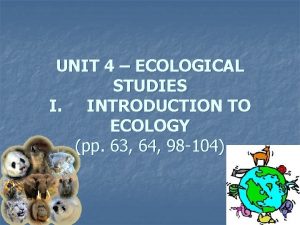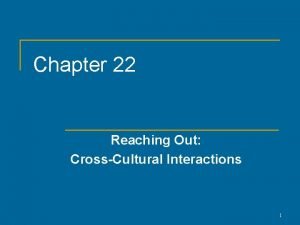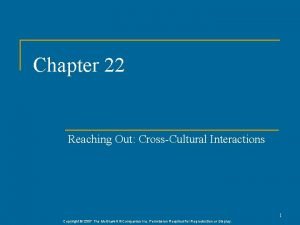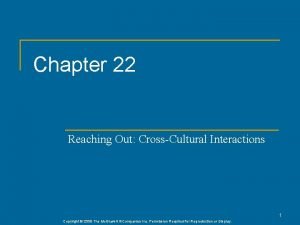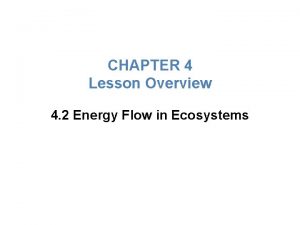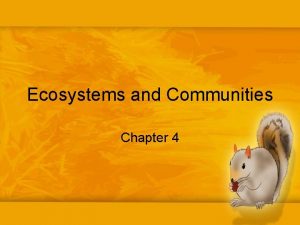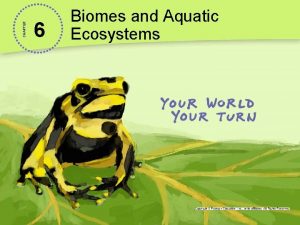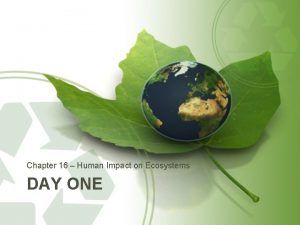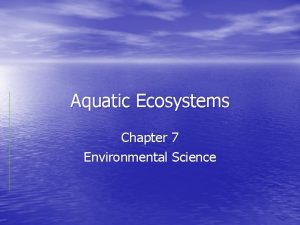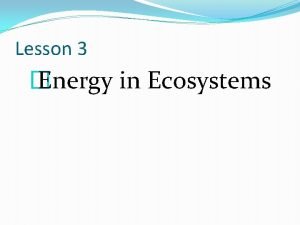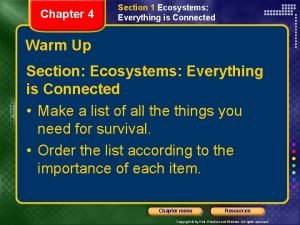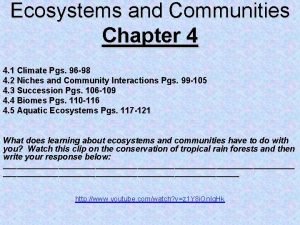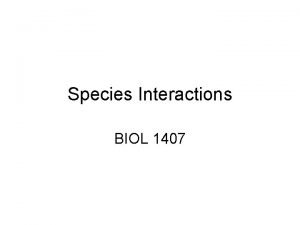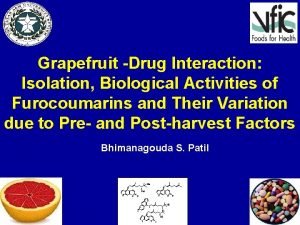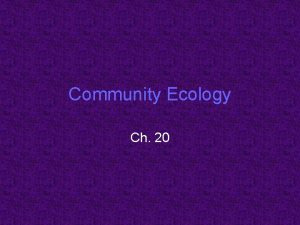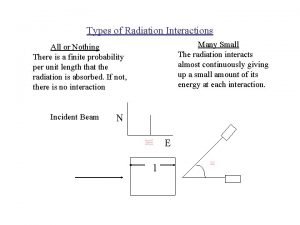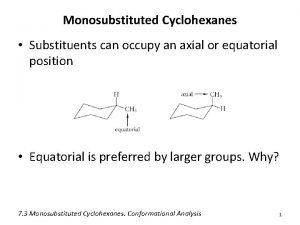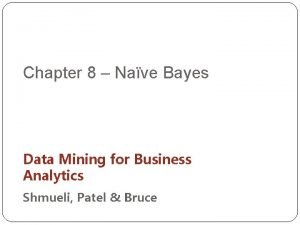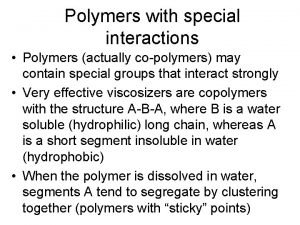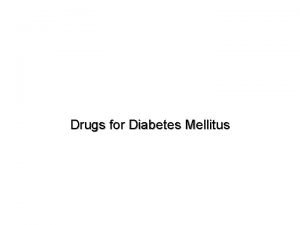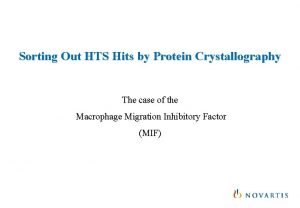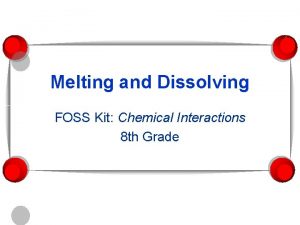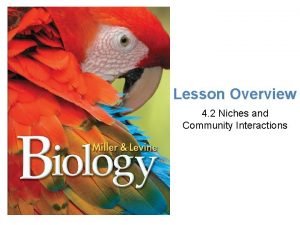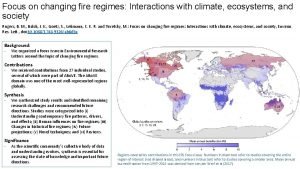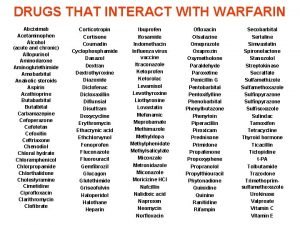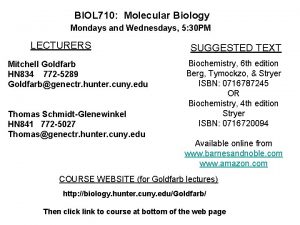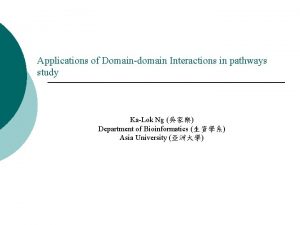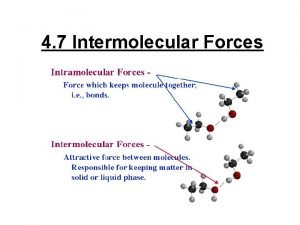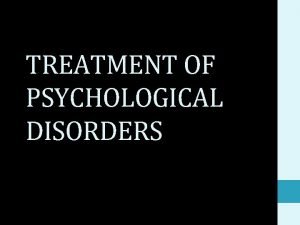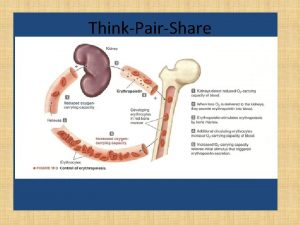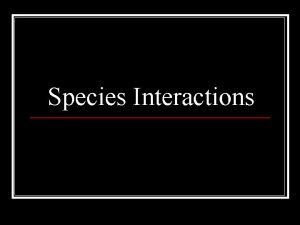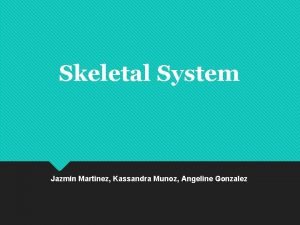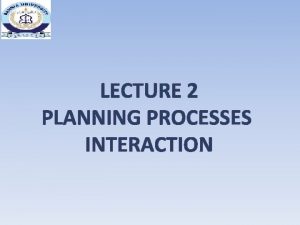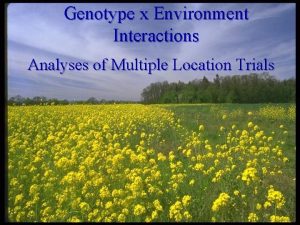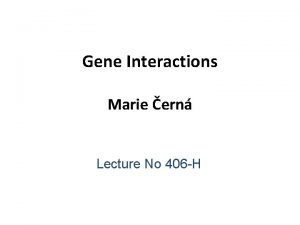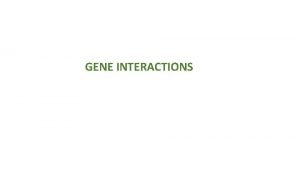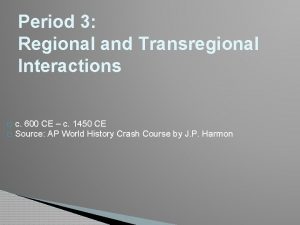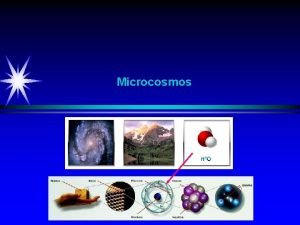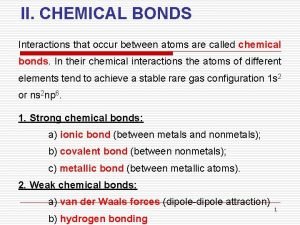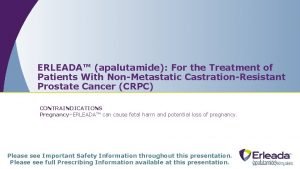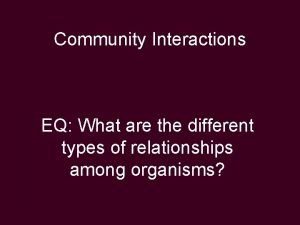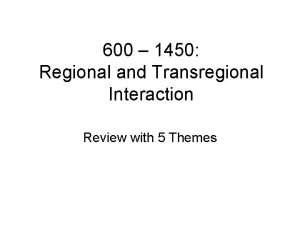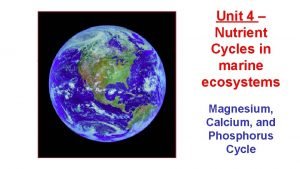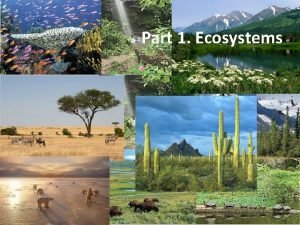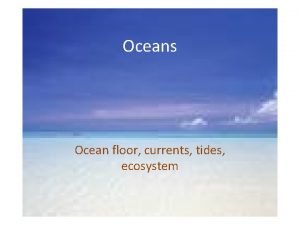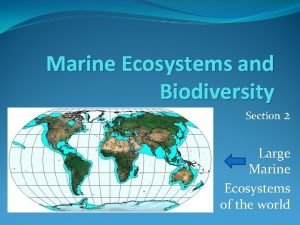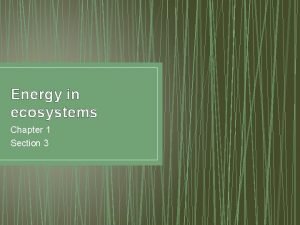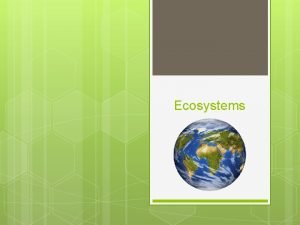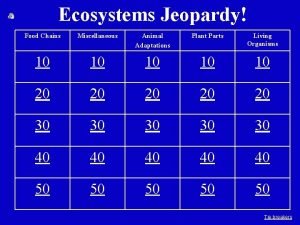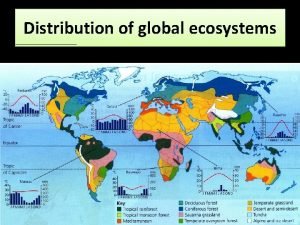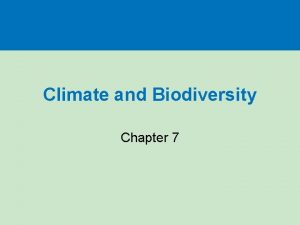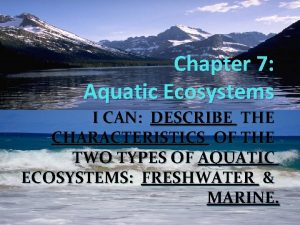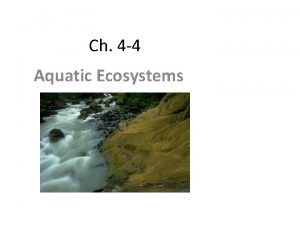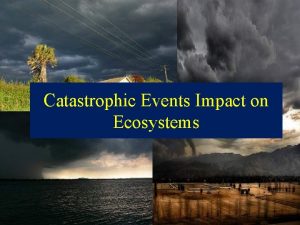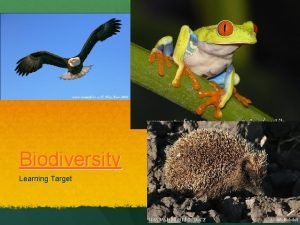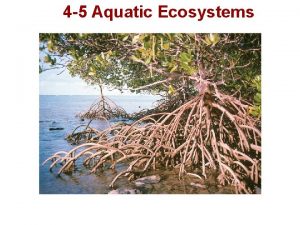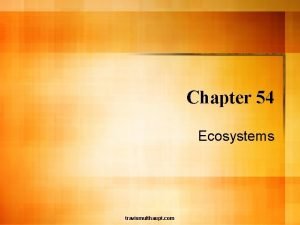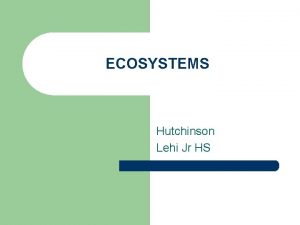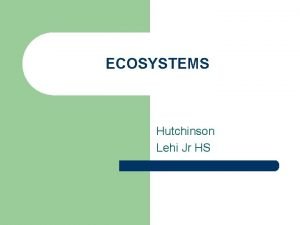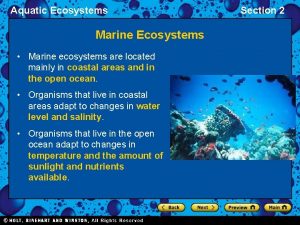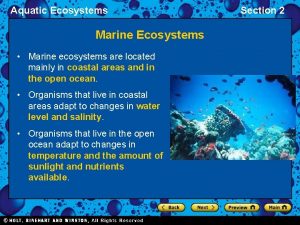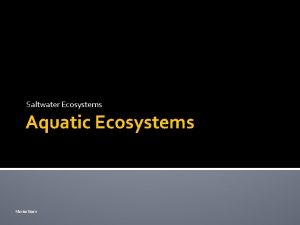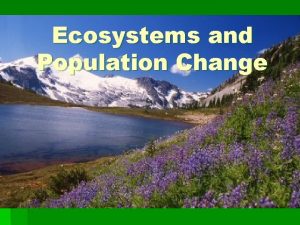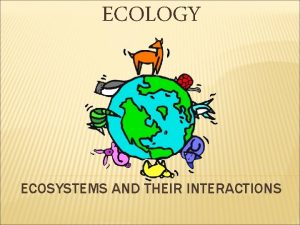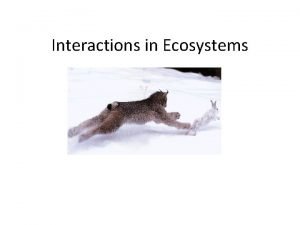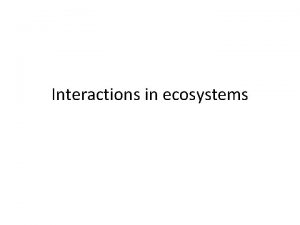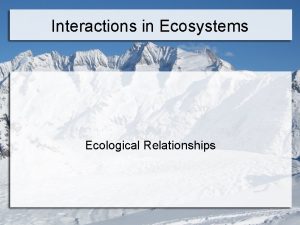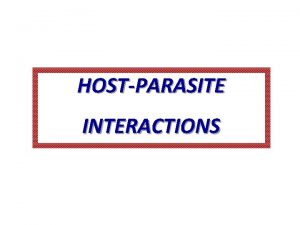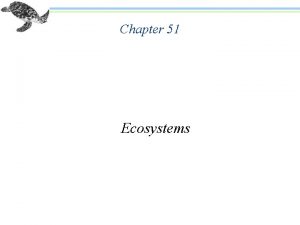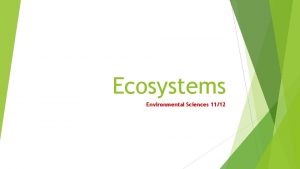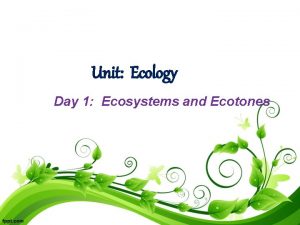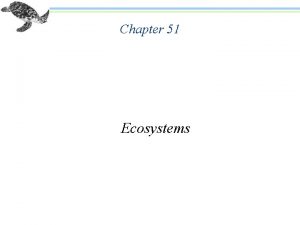UNIT 5 Chapter 14 Interactions in Ecosystems UNIT










































































































- Slides: 106

UNIT 5 Chapter 14 Interactions in Ecosystems

UNIT 5: ECOLOGY Chapter 14: Interactions in Ecosystems I. Habitat and Niche (14. 1) A. A habitat differs from a niche 1. habitat- all of the biotic and abiotic factors in the area where an organism lives. (where a species lives)

2. niche- composed of all the physical, chemical and biological factors that a species needs to survive, stay healthy, and reproduce. (how it lives within the habitat)

a. Food- type of food species eats, how it competes for food, and where it fits in the food web. b. Abiotic conditions- includes range of conditions such as air temperature, amount of water c. Behavior- time of day species is active, where and when reproduces, etc.

B. Resource availability gives structure to a community. 1. Competitive exclusion- when two species are competing for same resources, one species will be better suited to the niche, and other species will be pushed into another niche or become extinct.

3. Competitive exclusion can result in other outcomes a. niche partitioning- dividing of niche by two competing species (e. g. top or tree, or bottom of tree)

b. Evolutionary response- divergent evolution resulting in selection of different successful traits.

c. Ecological Equivalents- species that occupy similar niches but live in different geographical regions. Madagascar South America

II. Community Interactions (14. 2) A. Competition and predation are two important ways in which organisms interact.

1. Competition- occurs when two organisms fight for the same limited resources.

a. Interspecific competition- competition between different species

b. Intraspecific competition - competition between organisms of same species

2. Predation- process by which one organism captures and feeds upon another organism.

B. Symbiosis is a close relationship between species (symbiosis- close ecological relationship between two or more organisms of different species that live in direct contact with one another) 1. Mutualism- both species benefit from one another

2. Commensalism- one receives an ecological benefit from another, while the other neither benefits nor is harmed.


3. Parasitism- similar to predation in that one organism benefits while the other is harmed


III. Population Density and Distribution (14. 3) A. Population density is the number of individuals that live in a defined area

1. Measurement of the number of individuals living in a defined space. 2. Can calculate

B. Geographic dispersion of a population shows how individuals in a population are spaced. 1. Population dispersion- way in which individuals of a population are spread in an area or a volume. 2. Can be clumped, uniform, or randomly dispersed

clumped

uniform

random

C. Survivorship curves help to describe the reproductive strategy of a species 1. Survivorship curve- generalized diagram showing the number of surviving members over time from a measured set of births.

2. Gives information about life history of species

IV. Population Growth Patterns (14. 4) A. Changes in population’s size are determined by immigration, births, emigration, and deaths. 1. Size of populations are usually changing

2. Four factors affect the size of a population a. immigration- movement of individuals into a population from another population

b. Births- births increase number of individuals in population

c. Emigration- movement of individuals out of a population and into another

d. Deaths- size of population decreases when individuals die.

B. Population growth is based on available resources 1. population growth determined by amount of resources available. 2. Two types of population growth a. Exponential growth- occurs when population size increases dramatically over period of time

Exponential growth

b. Logistic growth- begins with period of slow growth, followed by brief exponential growth before leveling off at a stable size. 1). Carrying capacity- maximum number of individuals of a particular species that the environment can support

2). Population crash- dramatic decline in size of population over a short time

C. Biological factors limit population growth 1. Limiting factor-factor that has the greatest affect on keeping down the size of a population 2. Two categories of limiting factors

a. Density-dependent- affected by number of individuals in a given area 1). Competition- compete for resources

2). Predation- population of predator can be limited by available prey

3). Parasitism and disease- spread quickly through dense populations

b. Density-independent limiting factors- aspects of environment that limit population growth regardless of density 1). Unusual weather-can affect entire food chain or web

2). Natural disasters- volcanoes, tsunamis, tornados, hurricanes, etc.

3). Human activities- destruction of habitat, introduction of non-native species

V. Ecological Succession (14. 5) A. Succession occurs following a disturbance in an ecosystem (succession- sequence of biotic changes that regenerate a damaged community or create a community in a previously uninhabited area)

1. Primary succession- development of ecosystem in areas that was previously uninhabited

a. pioneer species- first organism to move into area like lichens and some mosses. b. Series of steps: bare rock → pioneer species → small plants → small animals → larger animals and plants

2. Secondary succession- reestablishment of a damaged ecosystem where soil was left intact (after fire, hurricane, etc. ) a. Plants and animals that remain start the process of regrowth.

b. dynamic process- are always changing the face of an ecosystem

Chapter 14 Populations

Which of the following is NOT one of the four factors that play a role in growth rate? a. immigration b. death rate c. emigration d. demography

Which of the following is NOT one of the four factors that play a role in growth rate? a. immigration b. death rate c. emigration d. demography

One of the main characteristics of a population is its a. change over time. b. geographic distribution. c. dynamics. d. habitat.

One of the main characteristics of a population is its a. change over time. b. geographic distribution. c. dynamics. d. habitat.

Sea otters are important to the populations of a. kelp. b. sea urchins. c. killer whales. d. all of the above

Sea otters are important to the populations of a. kelp. b. sea urchins. c. killer whales. d. all of the above

There are 150 Saguaro cacti plants per square kilometer in a certain area of Arizona desert. To which population characteristic does this information refer? a. growth rate b. geographic distribution c. age structure d. population density

There are 150 Saguaro cacti plants per square kilometer in a certain area of Arizona desert. To which population characteristic does this information refer? a. growth rate b. geographic distribution c. age structure d. population density

Which of the following tells you population density? a. the number of births per year b. the number of frogs in a pond c. the number of deaths per year d. the number of bacteria per square millimeter

Which of the following tells you population density? a. the number of births per year b. the number of frogs in a pond c. the number of deaths per year d. the number of bacteria per square millimeter

When organisms move into a given area from another area, what is taking place? a. immigration b. emigration c. population shift d. carrying capacity

When organisms move into a given area from another area, what is taking place? a. immigration b. emigration c. population shift d. carrying capacity

When organisms move out of the population they were born in, it is known as a. emigration. b. abandonment. c. immigration. d. succession.

When organisms move out of the population they were born in, it is known as a. emigration. b. abandonment. c. immigration. d. succession.

What occurs in a population as it grows? a. The birthrate becomes higher than the death rate. b. The birthrate stays the same and the death rate increases. c. The birthrate becomes lower than the death rate. d. The birthrate and the death rate remain the same.

What occurs in a population as it grows? a. The birthrate becomes higher than the death rate. b. The birthrate stays the same and the death rate increases. c. The birthrate becomes lower than the death rate. d. The birthrate and the death rate remain the same.

What is happening in a population as it decreases? a. The birthrate and the death rate remain the same. b. The death rate becomes lower than the birthrate. c. The death rate stays the same and the birthrate increases. d. The death rate becomes higher than the birthrate.

What is happening in a population as it decreases? a. The birthrate and the death rate remain the same. b. The death rate becomes lower than the birthrate. c. The death rate stays the same and the birthrate increases. d. The death rate becomes higher than the birthrate.

If immigration and emigration numbers remain equal, which is the most important contributing factor to a slowed growth rate? a. increased birthrate b. constant death rate c. decreased birthrate d. constant birthrate

If immigration and emigration numbers remain equal, which is the most important contributing factor to a slowed growth rate? a. increased birthrate b. constant death rate c. decreased birthrate d. constant birthrate

Which are two ways a population can decrease in size? a. immigration and emigration b. increased death rate and immigration c. decreased birthrate and emigration d. emigration and increased birthrate

Which are two ways a population can decrease in size? a. immigration and emigration b. increased death rate and immigration c. decreased birthrate and emigration d. emigration and increased birthrate

When individuals in a population reproduce at a constant rate, it is called a. logistic growth. b. growth density. c. exponential growth. d. multiple growth.

When individuals in a population reproduce at a constant rate, it is called a. logistic growth. b. growth density. c. exponential growth. d. multiple growth.

The various growth phases through which most populations go are represented on a(an) a. logistic growth curve. b. exponential growth curve. c. normal curve. d. population curve.

The various growth phases through which most populations go are represented on a(an) a. logistic growth curve. b. exponential growth curve. c. normal curve. d. population curve.

Which of the following describes how fast the human population is growing? a. slowly b. The population is remaining stable. c. exponentially d. The population is decreasing.

Which of the following describes how fast the human population is growing? a. slowly b. The population is remaining stable. c. exponentially d. The population is decreasing.

When the exponential phase of a logistic growth curve of a population ceases, a. the size of the population drops. b. the size of the population stays the same. c. population growth begins to slow down. d. population growth begins to speed up.

When the exponential phase of a logistic growth curve of a population ceases, a. the size of the population drops. b. the size of the population stays the same. c. population growth begins to slow down. d. population growth begins to speed up.

A biotic or an abiotic resource in the environment that limits the size of a population is a a. carrying capacity. b. limiting nutrient. c. limiting factor. d. growth factor.

A biotic or an abiotic resource in the environment that limits the size of a population is a a. carrying capacity. b. limiting nutrient. c. limiting factor. d. growth factor.

The number of organisms that an environment can support over a relatively long period of time is called a. carrying capacity. b. logistic growth. c. exponential growth. d. limiting factor.

The number of organisms that an environment can support over a relatively long period of time is called a. carrying capacity. b. logistic growth. c. exponential growth. d. limiting factor.

Which will reduce competition within a species’ population? a. fewer individuals b. higher birthrate c. fewer resources d. higher density

Which will reduce competition within a species’ population? a. fewer individuals b. higher birthrate c. fewer resources d. higher density

If a population grows larger than the carrying capacity of the environment, the a. death rate may rise. birthrate may rise. c. death rate must fall. d. birthrate must fall.

If a population grows larger than the carrying capacity of the environment, the a. death rate may rise. birthrate may rise. c. death rate must fall. d. birthrate must fall.

Each of the following is a density-dependent limiting factor EXCEPT a. competition. b. predation. crowding. disease.

Each of the following is a density-dependent limiting factor EXCEPT a. competition. b. predation. crowding. disease.

Which of the following is a density-dependent factor? a. earthquake b. disease c. emigration d. immigration

Which of the following is a density-dependent factor? a. earthquake b. disease c. emigration d. immigration

Human population growth has slowed down in a. China. b. the United States. c. India. d. Africa.

Human population growth has slowed down in a. China. b. the United States. c. India. d. Africa.

Demography is the scientific study of a. democratic societies. b. modernized countries. c. human populations. d. economic transitions.

Demography is the scientific study of a. democratic societies. b. modernized countries. c. human populations. d. economic transitions.

The demographic transition is change from high birthrates and high death rates to a. exponential growth. b. a low birthrate and a low death rate. c. a low birthrate and a high death rate. d. indefinite growth.

The demographic transition is change from high birthrates and high death rates to a. exponential growth. b. a low birthrate and a low death rate. c. a low birthrate and a high death rate. d. indefinite growth.

About 500 years ago, the world’s population started a. decreasing. b. to reach carrying capacity. c. growing more rapidly. d. to level off.

About 500 years ago, the world’s population started a. decreasing. b. to reach carrying capacity. c. growing more rapidly. d. to level off.

The human population experienced exponential growth after a. agriculture began. b. plowing and irrigation began. c. the bubonic plague began. d. the industrial revolution began.

The human population experienced exponential growth after a. agriculture began. b. plowing and irrigation began. c. the bubonic plague began. d. the industrial revolution began.

The anticipated human population by the year 2050 may be about a. 7. 8 billion. b. 9 billion. c. 9 trillion. d. 78 billion.

The anticipated human population by the year 2050 may be about a. 7. 8 billion. b. 9 billion. c. 9 trillion. d. 78 billion.

In countries like India, the human population is growing a. exponentially. b. transitionally. c. logistically. demographically.

In countries like India, the human population is growing a. exponentially. b. transitionally. c. logistically. demographically.

Most of the worldwide human population is growing exponentially because a. they have not reached their exponential curve. b. they have not yet completed the demographic transition. c. human populations do not conform to the logistic model. d. science and technology have made it possible.

Most of the worldwide human population is growing exponentially because a. they have not reached their exponential curve. b. they have not yet completed the demographic transition. c. human populations do not conform to the logistic model. d. science and technology have made it possible.
 Which of the following tells you population density
Which of the following tells you population density Interactions within ecosystems grade 7
Interactions within ecosystems grade 7 Commensalism in science definition
Commensalism in science definition Chapter 5 evolution and community ecology answer key
Chapter 5 evolution and community ecology answer key Chapter 22 reaching out cross-cultural interactions
Chapter 22 reaching out cross-cultural interactions Chapter 22 reaching out cross-cultural interactions
Chapter 22 reaching out cross-cultural interactions Chapter 22 reaching out cross-cultural interactions
Chapter 22 reaching out cross-cultural interactions Niches biology
Niches biology Section 3 aquatic ecosystems worksheet answers
Section 3 aquatic ecosystems worksheet answers Chapter 4 lesson 2 energy flow in ecosystems
Chapter 4 lesson 2 energy flow in ecosystems Chapter 4 ecosystems and communities vocabulary review
Chapter 4 ecosystems and communities vocabulary review The chaparral biome is best characterized by _______.
The chaparral biome is best characterized by _______. 6 biomes and aquatic ecosystems
6 biomes and aquatic ecosystems Chapter 55 ecosystems and restoration ecology
Chapter 55 ecosystems and restoration ecology Chapter 42 ecosystems and energy
Chapter 42 ecosystems and energy Chapter 3 lesson 3 biomes and aquatic ecosystems
Chapter 3 lesson 3 biomes and aquatic ecosystems Chapter 16 human impact on ecosystems
Chapter 16 human impact on ecosystems Limestone ridges built by tiny animals
Limestone ridges built by tiny animals Energy in ecosystems lesson 3 answer key
Energy in ecosystems lesson 3 answer key Chapter 7 aquatic ecosystems test answers
Chapter 7 aquatic ecosystems test answers Chapter 5 how ecosystems work study guide
Chapter 5 how ecosystems work study guide Chapter 16 human impact on ecosystems
Chapter 16 human impact on ecosystems Chapter 55 ecosystems and restoration ecology
Chapter 55 ecosystems and restoration ecology Section ecosystems everything is connected
Section ecosystems everything is connected Chapter 4 ecosystems and communities
Chapter 4 ecosystems and communities Noncovalent interactions
Noncovalent interactions Interactions among branches of government
Interactions among branches of government Competition symbiotic relationship
Competition symbiotic relationship Example of commensalism
Example of commensalism Application forms qualitative or quantitative
Application forms qualitative or quantitative Sertraline interactions
Sertraline interactions Unit 5 macroeconomics lesson 2 activity 45 answer key
Unit 5 macroeconomics lesson 2 activity 45 answer key The properties and interactions of magnets
The properties and interactions of magnets Grapefruit-drug interactions chart
Grapefruit-drug interactions chart Branch of biology dealing with interactions among organisms
Branch of biology dealing with interactions among organisms Earth sphere interactions
Earth sphere interactions Section 20-1 review species interactions
Section 20-1 review species interactions The mimosa plant displays thigmotropism
The mimosa plant displays thigmotropism Ppi drug interactions
Ppi drug interactions Types of interactions
Types of interactions Circulatory system interactions with other systems
Circulatory system interactions with other systems Modular vs integral product architecture example
Modular vs integral product architecture example Axial substituents
Axial substituents Ppi drug interactions
Ppi drug interactions List down factors influencing communication
List down factors influencing communication Symbiosis and species interactions keystone webquest
Symbiosis and species interactions keystone webquest Pathway of food through digestive tract
Pathway of food through digestive tract Naive bayes pays attention to complex interactions and
Naive bayes pays attention to complex interactions and Beri beri
Beri beri Modular product architectures
Modular product architectures Special interactions
Special interactions Cholinomimetic
Cholinomimetic Accounting information system chapter 1
Accounting information system chapter 1 Protein binding interactions
Protein binding interactions Nutrient interactions
Nutrient interactions Foss chemical interactions
Foss chemical interactions Niches and community interactions
Niches and community interactions Interactions
Interactions Dicloxaxillin
Dicloxaxillin Molecular biology
Molecular biology Protein binding interactions
Protein binding interactions Intermolecular force
Intermolecular force Protein binding interactions
Protein binding interactions Reflection wave interactions
Reflection wave interactions The maximum distance a wave varies from its rest position
The maximum distance a wave varies from its rest position Insight therapies involve verbal interactions
Insight therapies involve verbal interactions Organization of the lymphatic system
Organization of the lymphatic system 5 major types of species interactions
5 major types of species interactions Angeline gonzalez
Angeline gonzalez Dna-protein interactions
Dna-protein interactions Do all em waves travel at the speed of light
Do all em waves travel at the speed of light Project management process interactions
Project management process interactions Wave interactions
Wave interactions Interactions among living things
Interactions among living things Nervous interactions with other systems
Nervous interactions with other systems Interactions
Interactions Epistasis types
Epistasis types Messenger rna sequence
Messenger rna sequence Regional and transregional interactions
Regional and transregional interactions Microcosmos macrocosmos
Microcosmos macrocosmos Interactions between atoms occur
Interactions between atoms occur Erleada drug interactions
Erleada drug interactions Parasitism
Parasitism Regional and transregional interactions
Regional and transregional interactions Water pollution impact on ecosystem
Water pollution impact on ecosystem Marine magnesium cycle
Marine magnesium cycle Lesson outline lesson 2 aquatic ecosystems answer key
Lesson outline lesson 2 aquatic ecosystems answer key Ecosystem living and nonliving things
Ecosystem living and nonliving things Objective of ecosystem
Objective of ecosystem Ocean food chain
Ocean food chain Ecosystems examples
Ecosystems examples Section 3 energy in ecosystems
Section 3 energy in ecosystems Biomes title page
Biomes title page Examples of abiotic factors
Examples of abiotic factors Jeopardy ecosystems
Jeopardy ecosystems Distribution of ecosystems
Distribution of ecosystems Human impact on terrestrial ecosystems
Human impact on terrestrial ecosystems Marine ecosystem webquest
Marine ecosystem webquest Def of secondary succession
Def of secondary succession Section 4-4 aquatic ecosystems
Section 4-4 aquatic ecosystems What impact does a tornado have on an ecosystem?
What impact does a tornado have on an ecosystem? Why biodiversity is important
Why biodiversity is important Aquatic vs terrestrial
Aquatic vs terrestrial What two locations are marine ecosystems usually located
What two locations are marine ecosystems usually located 4-4 aquatic ecosystems
4-4 aquatic ecosystems Regents biology food chains and energy in ecosystems
Regents biology food chains and energy in ecosystems 4-4 aquatic ecosystems
4-4 aquatic ecosystems


